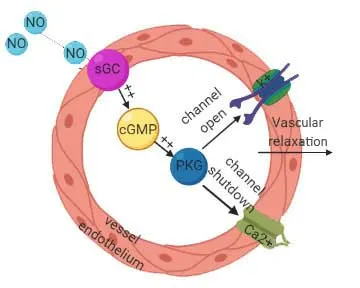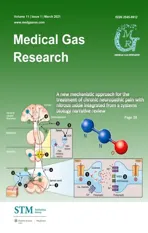The role of nitric oxide in peptic ulcer:a narrative review
2021-03-03TianYuLiangRuMingDengXiangLiXiangXuGangChen
Tian-Yu Liang,Ru-Ming Deng,Xiang Li,Xiang Xu,Gang Chen
Department of Neurosurgery & Brain and Nerve Research Laboratory,the First Affiliated Hospital of Soochow University,Suzhou,Jiangsu Province,China
Abstract Peptic ulcer refers to the inflammatory response and necrotic lesions of the mucosa under the action of various pathogenic factors,which goes deeply into the mucosal muscle layer and often occurs to the gastrointestinal mucosa related to gastric acid secretion,among which the stomach and duodenum are the most common.The clinical manifestations include slow onset,prolonged course and weekly upper abdominal pain.Nitric oxide (NO) is an intracellular and intercellular signaling molecule that plays an important role in many physiological and pathological processes.Studies have found that a small amount of NO produced in vivo plays a role in many physiological homeostasis,such as regulating blood pressure,platelet aggregation,nitrogenization of hemoglobin,and regulating proliferation and differentiation of stem cells.However,under the action of some cytokines and oxidative stress,intracellular NO synthase will catalyze the synthesis of large amounts of NO and participate in the inflammatory response,causing beneficial or harmful effect on the body.Numerous basic studies have focused on the relationship between NO and peptic ulcer.The purpose of this review is to summarize the role of NO in peptic ulcer and its possible mechanism.
Key words:inflammation; nitric oxide synthase; nitric oxide; peptic ulcer; pH; prostaglandin; vascular smooth muscle; vessel endothelium
INTRODUCTION
Peptic ulcer disease refers a mucosal break deeper than 3-5 mm in the duodenum or stomach.1It is mainly due to the imbalance of protective and injury factors between gastric mucosa and duodenum.Gastric ulcer and duodenal ulcer are similar in appearance,often accompanied by upper or posterior sternum pain,early satiety,nausea,bloating,or post-meal pain.These symptoms are nonspecific and may be clinically difficult to distinguish from functional dyspepsia.Studies have shown a low correlation between symptoms and endoscopic results.2Instead,patients may not develop symptoms until complications appear,or an ulcer may be accidentally discovered during an endoscopy for other reasons.Peptic ulcer can lead to serious complications such as bleeding or perforation,which can lead to a high death rate.3In recent years,peptic ulcer is still one of the most common diseases of the digestive system and the incidence of peptic ulcer disease is 1-2 per 1000 person-years,4-6although its occurrence rates have decreased slightly.3,7But many studies have shown that peptic ulcer complications have not decreased and are increasing year by year.8The pathogenesis of peptic ulcer is mainly related to the injury of gastric and duodenal mucosa,it is reported that 70% of gastric ulcers and 90% of duodenal ulcers are related to Helicobacter pylori and because of its serious harm,it is urgent to curb its spread.9-12Non-steroidal anti-inflammatory drugs (NSAIDs) and other medications such as aspirin are important factors which cause peptic ulcer.Noteworthily,NSAID seems to be more likely to cause gastric ulcers,the mechanism of which is unknown.13,14In addition,there are many causes of peptic ulcer,such as selective serotonin reuptake inhibitors,15Zollinger-Ellison syndrome,physiological stress associated with serious trauma and critical illness,16cigarette smoking.17With the exploration of more pathogenic factors of peptic ulcer,it is beneficial to us to understand its pathogenesis and put forward relevant prevention,diagnosis and treatment strategies.
Nitric oxide (NO) was once considered to be a kind of harmful gas,which can be converted into nitrogen dioxide in air and damage to the respiratory tract,even can cause pulmonary fibrosis,the methemoglobin levels can lead to disease.In recent years,it is generally believed that NO,as a biological signal molecule,plays an important role in human signal transduction.One of the most important functions is to act on the smooth muscle cells of the blood vessels to relax the blood vessels.18,19Due to the extensive research on NO,some studies have shown that the role of NO includes regulating vasodilation and contraction of blood vessels,participating in inflammatory response,and coagulation process,and regulating cell cycle.In peptic ulcer,NO takes an important role in keeping the gastric mucosa20health.NO is mainly synthesized by NO synthase (NOS),and three NOS subtypes have been shown to exist in the gastrointestinal tract,neuronal NOS,endothelial NOS and inducible NOS.NOS composed to neuronal NOS or endothelial NOS is involved in maintaining gastrointestinal mucosal integrity by regulating gastric mucosal blood flow,mucous secretion and defense barrier.However,NO synthesized by inducible NOS is involved in tissue damage in the inflammatory response.Several pieces of evidence showed that NO can be used as a protective agent for gastric ulcer by promoting mucosal blood flow,stimulating gastric mucus secretion and reducing leukocyte infiltration (Table1).21-23

Table1:The role of nitric oxide in peptic ulcer
THE CRITICAL ROLE OF NITRIC OXIDE INCREASES THE PH IN THE STOMACH
Existing studies have shown that stimulation can improve the pH of gastric environment.24,25A common phenomenon after gastric injury called gastric alkaline reaction,which is characterized as increased gastric pH after injury,has been shown to be mediated by endogenous peptidoglycans (PGs)pathway.26Further researches also show that the generation and release of endogenous NO could increase the pH somehow.27After exposure of the stomach to hypertonic sodium chloride solution,acid secretion stopped.We found that when NOS inhibitor nitro-L-arginine methyl ester was added,gastric pH stopped rising,which is suggesting that NO may be related to this gastric alkaline reaction.Besides,slight stimulation to gastric mucosa could also activate NOS to increase the local release of NO,promote gastric alkaline reaction and adaptive cell protection.This condition can also be supported by the fact that the adding D-arginine in the same experimental conditions was completely ineffective in antagonizing the inhibitory action of nitro-L-arginine methyl ester on gastric alkaline response.We believe that mild mucosal stimulation may activate NOS,increase the local release of NO,and promote gastric alkaline response and adaptive cell protection.Previous studies indicated that NO could promote cyclooxygenase activity through a kind of mechanism independent of cyclic guanosine-3′,5′-monophosphate.28They also noted that when NO synthase and cyclooxygenase systems are existed at the same time,there is a no-mediated increase in PGs production,which may lead to multiple pro-inflammatory effects.Therefore,it is reasonable for us to deduce that NO may control the release and biosynthesis of endogenous PGs after gastric injury,while NO strengthens the gastric alkaline response by inhibiting gastric acid secretion in directly or indirectly way through endogenous PGs mediated.In summary,the results indicate that the gastric alkaline reaction observed after hypertonic sodium chloride solution treatment is mediated by endogenous NO and PGs pathways.25,29It is believed that inflammatory cells such as macrophages,granulocytes in the mucosa and vascular endothelial cells may be involved in the release of NO by hypertonic sodium chloride.
THE CRITICAL ROLE OF NITRIC OXIDE IN VASCULAR SYSTEM
Peptic ulcer is usually thought to be caused by an imbalance between aggressive factors and antagonistic defense mechanisms.The most aggressive factor is the use of NSAIDs.30Decreased mucosal blood flow is considered to be the main mechanism of gastric injury caused by NSAID.31Mucosal defense mechanisms are mechanisms by which the mucosa remains stable despite frequent exposure to various stimuli,such as changes in temperature,pH and osmotic pressure,toxic substances,bacterial products,and inflammatory infiltration.32Microcirculation perfusion of gastric mucosa provides essential substances for epithelial cells,and plays a key role in removing metabolic substances and foreign bodies,maintaining normal secretion of mucus,and maintaining pH in the stomach.33In conclusion,the mucosa becomes more fragile when blood flow decreases.34NO synthesized by endothelial NOS acts on vascular smooth muscle to make it relaxed,thereby enhancing local blood flow.Meanwhile,it also increases blood flow by stimulating mucosal angiogenesis in the wound.35The mechanism of NO causing vascular smooth muscle relaxation is NO binds to Fe2+-heme of soluble guanylyl-cyclase effectively activates soluble guanylyl-cyclase and promote the production of cyclic guanosine-3′,5′-monophosphate.The second messenger (cyclic guanosine-3′,5′-monophosphate) immediately activates protein kinase G and then launches the signal cascades,such as K+channels.Activation of K+channels leads to hyperpolarization of cell membranes,and Ca2+channels are blocked,leading to relaxation of blood vessels (Figure1).36Histamine and bradykinin induced vasodilation is considered to be a powerful vasodilator,and its mechanism is to stimulate endothelial cells to release NO.37On the other side,numerous studies have shown that because of the insufficient release of NO,vascular endothelial cells are damaged and vasodilation is restricted.38In addition,vascular endothelial growth factor can stimulate the expression of endothelial NOS in endothelial cells to produce active NO to stimulate angiogenesis and repair damaged endothelial cells.39
THE CRITICAL ROLE OF NITRIC OXIDE IN INFLAMMATION

Figure1:The mechanism of nitric oxide (NO) causing vascular smooth muscle relaxation is NO binds to soluble guanylyl-cyclase (sGC) effectively activates sGC and promote the production of cyclic guanosine-3′,5′-monophosphate(cGMP).
The immune system in the lining of the gastrointestinal tract ensures that the gastrointestinal tract remains stable against various microorganisms,microbial products,and other antigens.Mutual adhesion between white blood cells and endothelial cells is considered a rate-control step in inflammatory response,so factors that regulate these cell-cell interactions have received considerable attention.Antibodies against white blood cells and endothelial cell adhesion molecules can reduce the degree of injury.NO is an important regulator of leukocyte adhesion to vascular endothelium under various acute inflammatory conditions.Increased NO can lead to decreased myeloperoxidase activity (an indicator of the number of neutrophils) and tissue damage.Existing studies have shown that fewer neutrophils infiltrate the gastric mucosa after administration of nitroprusside or acetylcholine.40Other studies have shown that NO inhibits the production of superoxide from neutrophils and directly inhibits NADPH oxidase.41Thus,in addition to removing superoxide,NO also prevents the synthesis of superoxide and related oxidants,including hydrogen peroxide.Both superoxide and hydrogen peroxide are involved in mucosal damage associated with ischemia reperfusion and NSAIDs.42,43Kubes et al.44provided the first clear evidence that inhibition of the NOS enzyme leads to inflammation.Further studies found that NOS inhibition enhanced leukocyte - endothelial interaction in rats.45Platelets are also thought to play a role in inflammatory processes,and NO is a very effective inhibitor of platelet aggregation and adhesion,46which may play an anti-inflammatory role by inhibiting platelet activation.Studies have suggested that the role of NO in anti-aggregation is regulated by increasing the level of cyclic guanosine-3′,5′-monophosphate in platelets.47In the gastrointestinal tract,the most significant immune regulatory role of NO is to inhibit the ability of mast cells to release mediators.Mast cells can produce NO,and NO produced by mast cells can automatically regulate the release of other inflammatory mediators.48On the other hand,H.pylorican induce the expression of inducible NOS in the pathogenesis of peptic ulcer.The increase of inducible NOS leads to duodenal epithelial injury,which can be inhibited by NOS inhibitors and superoxide dismutase inhibitors.These findings indicate that NO binds to superoxide to produce peroxynitrite that is involved in epithelial damage associated withH.pyloriinfection.49
CONCLUSION
In recent years,the study of NO as a signaling molecule emerges in endlessly.We should correctly recognize and profoundly understand the different effects of NO in peptic ulcer,which leads to a great awareness of the pathological process,and provides a better solution for future clinical diagnosis and treatment.
Author contributions
Manuscript writing:TYL,RMD; manuscript revision:XL,XX,GC;manuscript drafting:XX,GC.All authors read and approved the final version of the paper for publication.
Conflicts of interest
The authors declare that they have no competing interests.
Financial support
None.
Copyright license agreement
The Copyright License Agreement has been signed by all authors before publication.
Plagiarism check
Checked twice by iThenticate.
Peer review
Externally peer reviewed.
Open access statement
This is an open access journal,and articles are distributed under the terms of the Creative Commons Attribution-NonCommercial-ShareAlike 4.0 License,which allows others to remix,tweak,and build upon the work non-commercially,as long as appropriate credit is given and the new creations are licensed under the identical terms.
杂志排行
Medical Gas Research的其它文章
- High-flow hydrogen inhalation might suppresses the immune function of middle-aged participants:a selfcontrolled study
- The effect of dexmedetomidine on decrease of cough,hemodynamic parameters and Ramsay score versus lidocaine during general anesthesia:a randomized clinical trial
- Evaluation of audible leak versus pressure volume loop closure for polyvinyl chloride cuff and polyurethane microcuff in endotracheal tube inflated with air:a prospective randomized study
- Therapeutic effects of hyperbaric oxygen:integrated review
- A new mechanistic approach for the treatment of chronic neuropathic pain with nitrous oxide integrated from a systems biology narrative review
- Hyperbaric oxygen therapy decreases mortality due to Fournier’s gangrene:a retrospective comparative study
